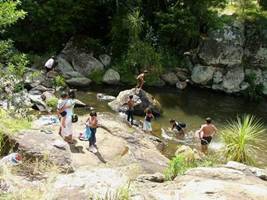Recreational Bathing Water Quality
The Northland Regional Council, in conjunction with the District Council's and Northland Health, survey the water quality at a number of the region's most popular freshwater bathing sites every summer.
Freshwater sites are not always safe for recreational activities, as waterways can sometimes become contaminated with human or animal effluent, which contains large numbers of organisms capable of causing illness. The most common sources of bacterial contamination are human sewage, stormwater and rural run-off, which can include bacteria from both agricultural land use and feral animals.
 Families enjoying the Raumanga Stream in Whangarei.
Families enjoying the Raumanga Stream in Whangarei.
Twenty three swimming sites at 20 of Northland's rivers, lakes and streams were sampled over a 12-week period, from the start of December 2004 through to the end of February 2005. Samples were collected weekly from each site and analysed for the pollution indicator bacteria, Escherichia coli (E. coli) following the recommended methods in the ‘Microbiological Water Quality Guidelines for Marine and Freshwater Recreational Areas' developed jointly by the Ministry for the Environment (MfE) and the Ministry of Health (MoH). The ‘Microbiological Water Quality Guidelines for Marine and Freshwater Recreational Areas' are available for viewing under publications on the Ministry for the Environment's website: www.mfe.govt.nz
The results were compared to the recommended guidelines and all results were forwarded to the district councils, as well as Northland Health, for follow up action when E. coli levels were elevated above the guidelines. The table below shows the guidelines used for microbiological water quality in relation to recreational bathing in Northland and the recommended follow up by District Council's based on the national guidelines above.
| E. Coli count (cells/100mL) | Status | Suggested follow up |
| Less than or equal to 260 | Acceptable | No response necessary – continue weekly sampling |
| Greater than 260 but less than or equal to 550 | Alert | Increase sampling to daily Undertake sanitary survey to isolate source of faecal contamination |
| Greater than 550 | Action | Increase sampling to daily Undertake sanitary survey Erect warning signs Inform public through the media that a public health risk exists |
